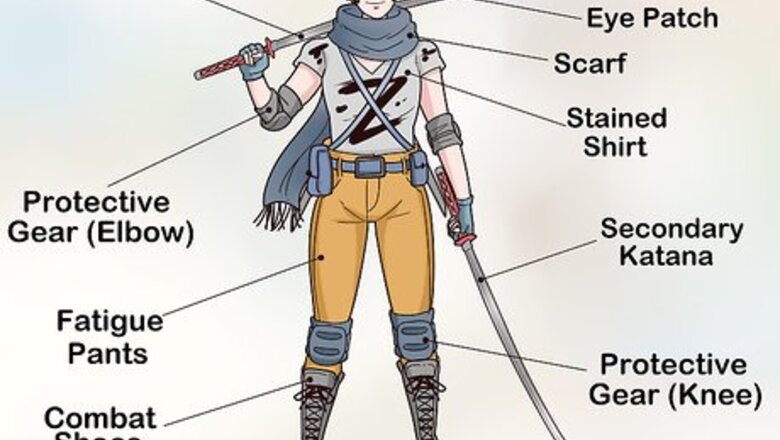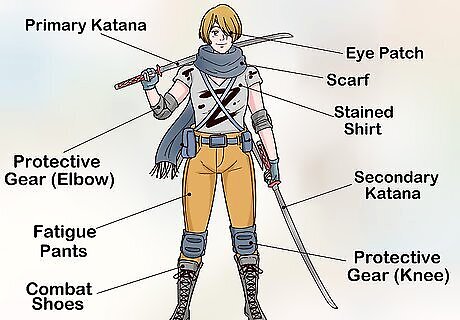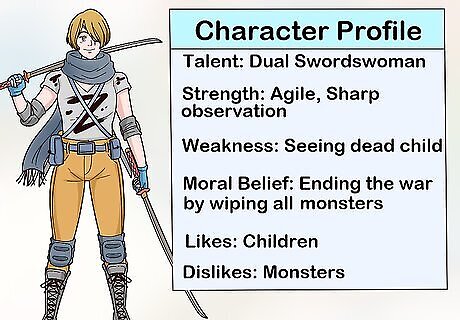
views
X
Research source
Describing a Character’s Physical Appearance

Start creating a character profile. A character profile includes a wide range of details about your character, including how they look, where they are from, what they do for a living, their likes and dislikes, and much more!This profile will be a useful organizing tool to reference throughout your writing process. At the beginning, it will help you determine which visual aspects of the character are important to share with readers. If you are an artist, draw a picture of your character. Provide as much detail as possible. The more details you know, the better you can pick out the unusual ones to share with readers. If you are not an artist, then try using a character illustration generator website or software to help you visualize your character. Don’t dress them in a generic plain t-shirt without you detailing what makes it different from every other shirt like it. Does it have any tears or old stains, indicating perhaps this is a favorite shirt? Maybe a logo or designer brand that shows their personal style or places they frequent.

Focus on your character’s unique attributes and/or personal quirks. Your goal is to create a visual snapshot of an interesting person your readers want to get to know better. Do not exhaustively detail every facet of your character’s appearance. Ask yourself, as an observer, what is the first thing you notice about this person? Do they have scars, tattoos, or unusual physical features (like wide, clear blue eyes) that stand out? Can you see their facial features or does a hat or pair of oversized sunglasses hide their face?

Use creative descriptors instead of simple adjectives. A description that does not encourage readers’ imaginations may be accurate, but will not be interesting. Use metaphors to compare two things that are unrelated, yet share a common feature. Examples of metaphors include “blind as a bat,” “a blanket of snow,” and “a heart of gold.” Instead of simply stating your character has green eyes, for example, describe the exact shade of green by referencing an object readers will recognize. Are they pea green, forest green, or the color of Crayola finger paint? Avoid clichés and aim for original comparisons. Clichés like “she is lovely as a rose” are so common that readers instantly recognize them without having to think about what they mean. This statement fails to say anything important about the woman since beauty is a subjective judgment. Be specific and use your imagination.
Describing a Character’s Personality

Expand on your character profile to include personality traits. List their talents, strengths and weaknesses, moral beliefs, likes and dislikes, and any other personal information you have considered. Readers don't need all of this information, but you need to know your character in and out to make decisions about what to present. Think about how they see themselves and how others would perceive them. Do these images match or clash? Do their dreams for the future match their talents and strengths? You want your reader to leave with an impression of who your character is as a person, not just what they look like.

Connect clothing and personal objects to the character’s personality. Are their clothes neatly pressed and tailored, indicating attention to their appearance, or do they look like they rolled out of bed and threw on whatever was nearest on the floor. Note anything that is absent that one would normally expect. Are they walking in the snow without a coat or shoes, or fully dressed head-to-toe in 100 degree weather?

Make him or her an active participant. Describing how your character interacts with his or her environment gives you a chance to offer insight into their intellect and conscious indirectly, so that your writing becomes a story and not just a biographical sketch. Be specific and concrete. If surfing the web, what type of sites are they looking at? If walking, are they taking large, confident strides or shuffling their feet? Even if s/he is doing "nothing," this fact provides insight into their personality and thoughts.

Include stream of consciousness and/or dialogue. When little direct action is taking place, recording the character's thoughts or conversations keeps the reader engaged. When using dialogue, note the speaker’s tone or inflection, any pauses or tics, or unusual words choices. Do they gesture while they speak or use meaningful body language? Are they saying what they really think or hiding their true nature?

Don’t limit active verbs to a character’s movement. Make their physical attributes active, as well. A long skirt might graze the floor, their hair may fly around wildly. Maybe their coffee cup sits motionless and loses its warmth because they are too preoccupied to drink.
Describing a Character’s Environment

Offer a visual sketch of the character’s immediate surroundings. Their surroundings should suggest something significant about their personality or state of mind. Your description should also set-up the scene for what is about to happen. If at their home, details concerning the location, size and condition of structure, how it is decorated, and your character’s housekeeping skills can offer clues as to their personality or habits. If your setting is a public space, like a coffee shop, tell readers whether the shop is a well-known chain, or a dive that few people even know about. Reveal if they sit in the back rather than in view of other patrons.

Appeal to your reader’s senses. Make sure to consider your audience so that you can appeal to their senses and expectations. Tell your audience what the character sees, feels, smells, or hears to make it more realistic and engaging. Don’t just tell your audience that your character is drinking coffee, give details about the type of coffee: straight espresso, a syrupy latte, or plain black Columbian coffee. Describe the scents in the shop, the noise from the drink machines, and the people chatting at tables nearby. Can they hear a dog barking outside? Is the sun permeating the window, forcing them to wear sunglasses?

Consider placing them in an uncomfortable environment. This is a great way to develop your character's personality. Explain how they got there: were they trying out a new place on their own, meeting someone for the first time, or are they really bad at reading directions? Describe what exactly about the scene makes them uncomfortable.



















Comments
0 comment